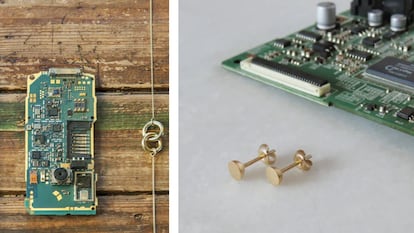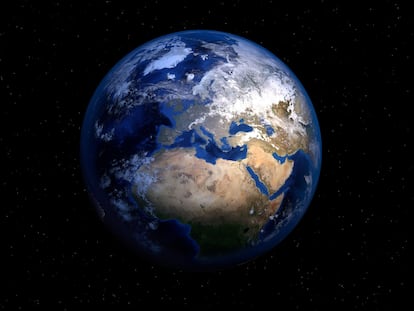Gold from old cell phones regains its sparkle
Companies are using precious metals and other minerals from electronic waste to create necklaces, rings and bracelets

Around 50 million tons of electronic waste are discarded every year – the equivalent of “enough Eiffel Towers to occupy the entire island of Manhattan,” according to the United Nations. Cell phones, computers and video game consoles conceal precious metals that can be recycled to create jewelry, and a number of brands have not been blind to the opportunity.
Only 17.4% of e-waste worldwide is recycled, according to data from The Global E-Waste Monitor 2020 report. Some of the remainder ends up in landfills where it releases toxins into the air, soil and groundwater. It’s a problem that could get worse considering that the amount of e-waste is expected to increase at an alarming rate. If more than 53 million tons of this waste were generated in 2019, that figure is predicted to rise to 74 million by 2030, according to the report.
The reason these devices are often packed with precious metals and minerals such as gold, silver, platinum and copper, is that these are good conductors of electricity. “Electronics companies spend a fortune buying and processing precious minerals, only to see them buried in landfills,” says the World Economic Forum. That’s precisely where some jewelry companies like Lylie, Nowa and AuTerra, come in.
In AuTerra’s case, they begin by manually dismantling the devices and separating their components. “The circuit boards go through a shredder before being fed into the furnace, giving us two materials: slag, which is a by-product that can be used in road construction, and a mixed metallic mass,” explains a company source. This mass is a combination of copper, gold, silver and other metals, which finally go through a recycling process and are melted “to guarantee a pure and high quality material.”
The environmental impact of mining
Recycling these devices could also help reduce mining activity, which has a major impact on the environment. Besides the direct destruction of habitats, mining means the displacement of wildlife, loss of vegetation, deforestation, erosion and alters soil profiles, according to a report on the social and environmental impact of mining in the European Union.
Extracting just 10 grams of gold displaces nearly five tons of earth, according to AuTerra, which portrays gold mining as “a destructive industry that results in ruined landscapes, displaced communities and the release of multiple toxic compounds into the air and groundwater.” It is an environmental impact that could in theory be reduced if gold were extracted directly from e-waste, according to a source at Lylie, a jewelry brand that works with a UK refinery to extract precious metals from these devices: “A typical cell phone contains 0.2 grams of gold and, with an average life expectancy of just 22 months, extracting and refining it results in a lower carbon footprint than primary mined gold.”
From an ecological point of view, “recycled gold is the best option, since two thirds of the planet’s gold has already been extracted,” according to Lylie, which also points out that extracting one ton of minerals from the earth yields 30 grams of gold. By contrast, “you get about 300 grams of this metal” with just one ton of e-waste.
“Our most important mining operations should be carried out in scrap yards and recycling centers, rather than in sensitive ecological areas and ancestral lands,” AuTerra points out. Even so, turning e-waste into gold is not without its challenges. Aside from the fact that some of the technology is particularly costly and inefficient, it is important that the process is carried out properly: “If recycling is not done correctly and in a controlled environment, there can be negative environmental consequences,” says AuTerra.
Despite the challenges, more and more jewelry companies are showing interest in recycled metals. In 2020, Danish brand Pandora, one of the largest jewelry manufacturers in the world, announced that, by 2025, all of its jewelry would be made from recycled gold and silver. “Considering that 7% of the world’s gold is currently found in disused electronic devices, no one can argue about the enormous potential here,” says Lylie, which indicates that recycled jewelry will soon become a trend. Meanwhile, a more circular industry is under construction.
Sign up for our weekly newsletter to get more English-language news coverage from EL PAÍS USA Edition
Tu suscripción se está usando en otro dispositivo
¿Quieres añadir otro usuario a tu suscripción?
Si continúas leyendo en este dispositivo, no se podrá leer en el otro.
FlechaTu suscripción se está usando en otro dispositivo y solo puedes acceder a EL PAÍS desde un dispositivo a la vez.
Si quieres compartir tu cuenta, cambia tu suscripción a la modalidad Premium, así podrás añadir otro usuario. Cada uno accederá con su propia cuenta de email, lo que os permitirá personalizar vuestra experiencia en EL PAÍS.
¿Tienes una suscripción de empresa? Accede aquí para contratar más cuentas.
En el caso de no saber quién está usando tu cuenta, te recomendamos cambiar tu contraseña aquí.
Si decides continuar compartiendo tu cuenta, este mensaje se mostrará en tu dispositivo y en el de la otra persona que está usando tu cuenta de forma indefinida, afectando a tu experiencia de lectura. Puedes consultar aquí los términos y condiciones de la suscripción digital.
More information
Últimas noticias
Nazareth Castellanos, neuroscientist: ‘We need to teach anxiety prevention techniques from school onwards’
Oona Chaplin: ‘I told James Cameron that I was living in a treehouse and starting a permaculture project with a friend’
Madrid, the second region in Europe with the most roundabouts thanks to urban speculation: One for every 30 intersections
Amy Taylor, singer of Amyl and the Sniffers: From selling nuts to opening for AC/DC
Most viewed
- Charles Dubouloz, mountaineering star, retires at 36 with a farewell tour inspired by Walter Bonatti
- CBS in crisis after pulling a report on Trump’s deportations to El Salvador (which later leaked online)
- Venezuela faces its most tense Christmas yet
- Bukele clan fumes over investigation exposing their new wealth
- Why we lost the habit of sleeping in two segments and how that changed our sense of time











































